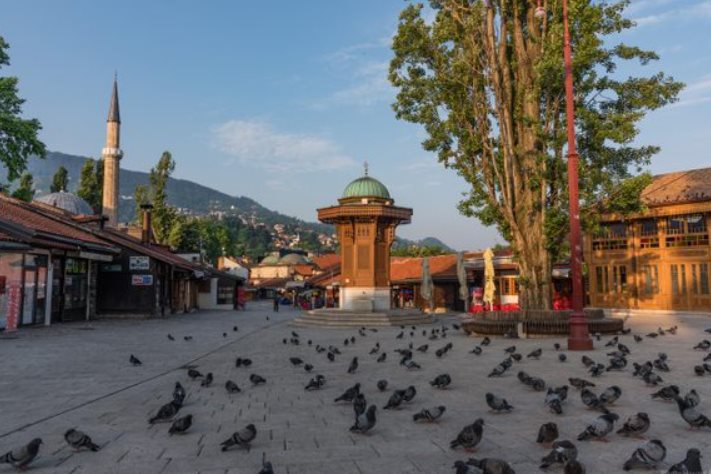Bascarsija stands as the ancient bazaar of Sarajevo, serving as the historical and cultural heart of the city. Constructed in the 15th century under the initiative of Isa-beg Ishaković, who founded the entire city, Bascarsija bears its name from the Turkish word “baş,” meaning “main,” making it the “main bazaar.” A significant portion of Bascarsija was unfortunately reduced to half its original size due to a massive fire in the 19th century.
In the 1940s, communist authorities contemplated complete destruction, but fortunately abandoned that plan. Situated on the northern bank of the Miljacka River, within the municipality of Stari Grad Sarajevo, Bascarsija houses key historical landmarks like Gazi Husref-beg’s mosque and the clock tower. Today, Bascarsija stands as the primary tourist attraction in Sarajevo.
Before the Ottoman era, the primary settlement in the Sarajevo field was the rural square of Tornik, located at the crossroads where Ali Pasha’s mosque now stands. Bascarsija took shape in 1462 when Isa-beg Ishaković constructed a han and numerous shops. At that time, the majority of Sarajevo’s population resided around the Imperial Mosque.
To connect the main Sarajevo settlement with the new economic center, Bascarsija, Isa-beg Ishaković built a bridge over the Miljacka, and around the main entrance, the Bazerdžana bazaar formed. Towards the west emerged the Kazaza bazaar, while on the northern side, Sedlara and Sarača bazaars (now Sarači Street) took shape. Noteworthy structures from this period include the renowned Bascarsija Mosque, built by Havedža Durak in 1528.
Gazi Husref-beg established his mosque in 1530, along with a medresa, library, hanikah, hamam, bezistan, Morića han, clock tower, and various other structures. Gazi Husref-beg’s final resting place is within the mosque’s courtyard, alongside the tomb of his freed slave and the first trustee of his endowment, Murat-beg Tardić.
Bascarsija reached its zenith in the second half of the 16th century, boasting 80 different crafts organized into robust guild associations. Streets were divided based on these crafts, with each street hosting shops for one or more related crafts (e.g., Kovači, Kazandžiluk, Sarači). This period witnessed the construction of numerous commercial structures, including bezistans, hans, and caravanserais. Sarajevo became a vital trade center in the Balkans, featuring three bezistans (Gazi Husref-beg’s Bezistan and Bursa Bezistan still exist). Mlečan and Dubrovčan colonies were also present.
During this time, Bascarsija had approximately 12,000 trade and craft shops. In 1640, Sarajevo experienced an earthquake, and in 1644 and 1656, several fires occurred. However, the renowned traveler Evlija Čelebija noted in 1660, “In the bazaar, there are a thousand and eighty shops, each a model of beauty. The bazaar itself is very attractive and well-planned.” Unfortunately, in 1697, Eugene of Savoy raided and devastated the entire city, sparing only a few buildings.
Until the 19th century, the city of Sarajevo saw minimal expansion. With the Austro-Hungarian occupation in 1878, foreign architects aimed to transform Sarajevo into a modern European city. A massive fire, which destroyed the entire old town except for the present-day area, established the famous boundary between Bascarsija and Ferhadija Street. Upon the liberation of Sarajevo in 1945, the new municipal council decided to gradually demolish Bascarsija, believing the old trading center had no place in a modern city. Nevertheless, Bascarsija managed to survive, embracing a modern standard by the 1970s.


